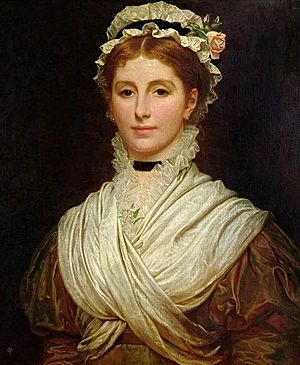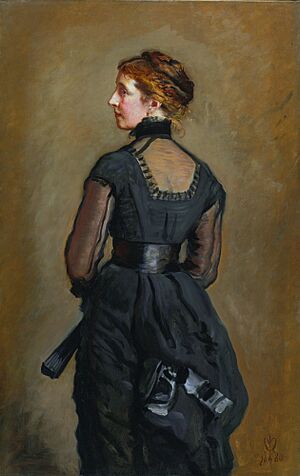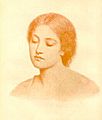Kate Perugini facts for kids
Quick facts for kids
Kate Perugini
|
|
|---|---|

Charles Perugini's portrait of his wife Kate
|
|
| Born |
Catherine Elizabeth Macready Dickens
29 October 1839 London, England
|
| Died | 9 May 1929 (aged 89) London, England
|
| Nationality | British |
| Education | Bedford College |
| Known for | Painting |
| Spouse(s) | |

Catherine Elizabeth Macready Perugini (born Dickens; 29 October 1839 – 9 May 1929) was an English painter. She lived during the Victorian era. Kate was the daughter of the famous writer Charles Dickens. Her mother was Catherine Dickens.
About Kate Perugini
Catherine Dickens was often called Kate or Katey. She was the youngest daughter of Charles Dickens who survived childhood. Her family said she was her father's favorite child. Charles Dickens reportedly named her after his friend, the actor William Macready. As a girl, she was also nicknamed "Lucifer Box." This was because she had a quick temper.
Kate traveled a lot with her family when she was young. She also acted in her father's plays. One famous play was The Frozen Deep in 1857. Queen Victoria even watched this performance. In 1858, her parents separated. The children stayed with their father.
Kate's first husband was the artist and writer Charles Allston Collins. He was the younger brother of Wilkie Collins. They got married on 17 July 1860. Charles Collins died from cancer in 1873.
After his death, Kate married another artist. His name was Charles Edward Perugini. They married secretly in 1873. Then they had an official ceremony in 1874. Kate and Charles Perugini had one child, Leonard Ralph Dickens Perugini. Sadly, he died at seven months old in 1876. The Peruginis were active in the art world. They were friends with famous people like J. M. Barrie and George Bernard Shaw. Kate also wrote, just like her first husband.
Kate was an important source for a book about her father. The book was called Dickens and Daughter. Charles Perugini died in 1918. He was buried next to their baby son. Kate lived ten years longer than her husband. She passed away at 89 years old.
Kate's Art Career
When she was 12, Kate Dickens started studying art. She went to Bedford College. This was the first college for women in Britain. She became a successful painter. She painted portraits and everyday scenes. Sometimes she worked with her husband, Charles Perugini. Kate wanted to be known for her own art. She did not want to be famous only because of her father.
In 1880, Sir John Everett Millais painted her portrait. It was one of his most striking paintings. The portrait was shown at the Grosvenor Gallery in 1881. This painting shows Kate with her back to the viewer. But her unique features are still visible. Millais gave this portrait to Kate as a wedding gift. It was for her marriage to Charles Perugini. Millais had also used Kate as a model before. She appeared in his painting The Black Brunswicker (1860).
Kate began showing her paintings at the Royal Academy of Arts in 1877. She also regularly exhibited her art. She showed her work at the Society of Watercolour Painters. She also exhibited at the Society of Lady Artists. Perugini sent three paintings to the Grosvenor Gallery. This was between 1880 and 1882. One painting was called Civettina (1880). It shows an Italian girl in profile. Her back is to the viewer.
Perugini also showed her art in Chicago, Illinois. This was at the 1893 World's Columbian Exposition. Her work was in the Palace of Fine Arts. It was also in The Woman's Building.
Kate Perugini is especially known for her portraits of children. Some of her famous works include:
- A Little Woman (1879)
- Feeding Rabbits (1884)
- Dorothy de Michele (1892)
- A Flower Merchant
Illustrations of works
See also
- Dickens family





